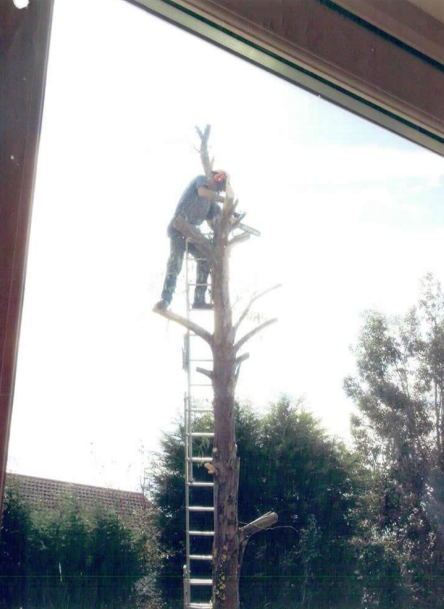
Does this look like a safe position in which to use a chainsaw’

Power tools such as chainsaws are useful but very dangerous pieces of equipment. When used improperly, they can cause serious injury, such as amputations, or even result in death.
This picture from the Health and Safety Executive in the UK shows a landscape gardener carrying out unsafe tree work. The gardener and an employee were felling a tree using a chainsaw, despite the fact that neither were qualified to do so or wearing PPE, such as protective trousers and boots.
In addition, the gardener was working in the crown of the tree without any kind of safety equipment that would have prevented a fall, such as a harness. And he was in an unstable position for the use of such hazardous equipment.
The two men were spotted by a neighbour, who happened to be trained to assess chainsaw work. The neighbour took the picture and reported his concerns to the HSE, which fined the gardener.
TIPS FOR SAFE USE OF CHAINSAWS
Always make sure you comply with the requirements in the OHS laws for power tools, such as chainsaws. And here are some tips for safely using chainsaws from WorkSafeNB:
Before chainsaws are used, ensure that they’re maintained and operated according to the manufacturer’s specifications. Below are a few rules to follow:
- Always check the chainsaw carefully to ensure all parts are present and working properly.
- Check the chain to ensure it’s sharpened to the manufacturer’s specifications and that it has adequate tension.
- Never refuel a saw while the engine is operating or near a source of ignition. Move at least three metres away from where you refueled before starting the engine.
- Employees who are required to operate chainsaws shouldn’t be permitted to work alone and must always have an adequate first aid kid onsite as well as someone trained in first aid.
- When working in the woods with chainsaws, there should be an emergency evacuation plan.
- Every chainsaw operator should carry or keep a pressure bandage nearby, as well as a round point shovel and suitable fire extinguisher.
When using a chainsaw, workers should always wear the following:
- Hardhat with a visor or safety glasses
- Hearing protection
- Safety boots with chainsaw protection, ankle support and slip-resistant soles
- Safety pants lined with chainsaw-resistant material extending up to the belt line rather than stopping at the upper thigh
- Leather gloves.
When operating a chainsaw, workers should:
- Keep both feet on a firm surface’not like the worker in the picture’and both hands on the saw.
- Start the saw against a solid object, below waist-level.
- Never start the saw one-handed, such as by pulling the cord with one hand while engaging the throttle with the other.
- Stop the motor before adjusting the chain.
- Never draw the saw toward themselves or operate it above shoulder height.
- Engage the brake or stop the motor before carrying the saw from one location to another.
You should also make sure that you comply with the requirements under the OHS laws for portable ladders, such as extension ladders.
